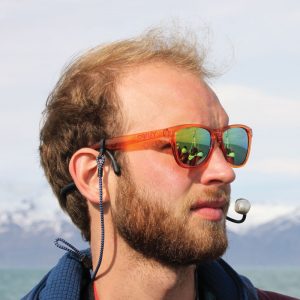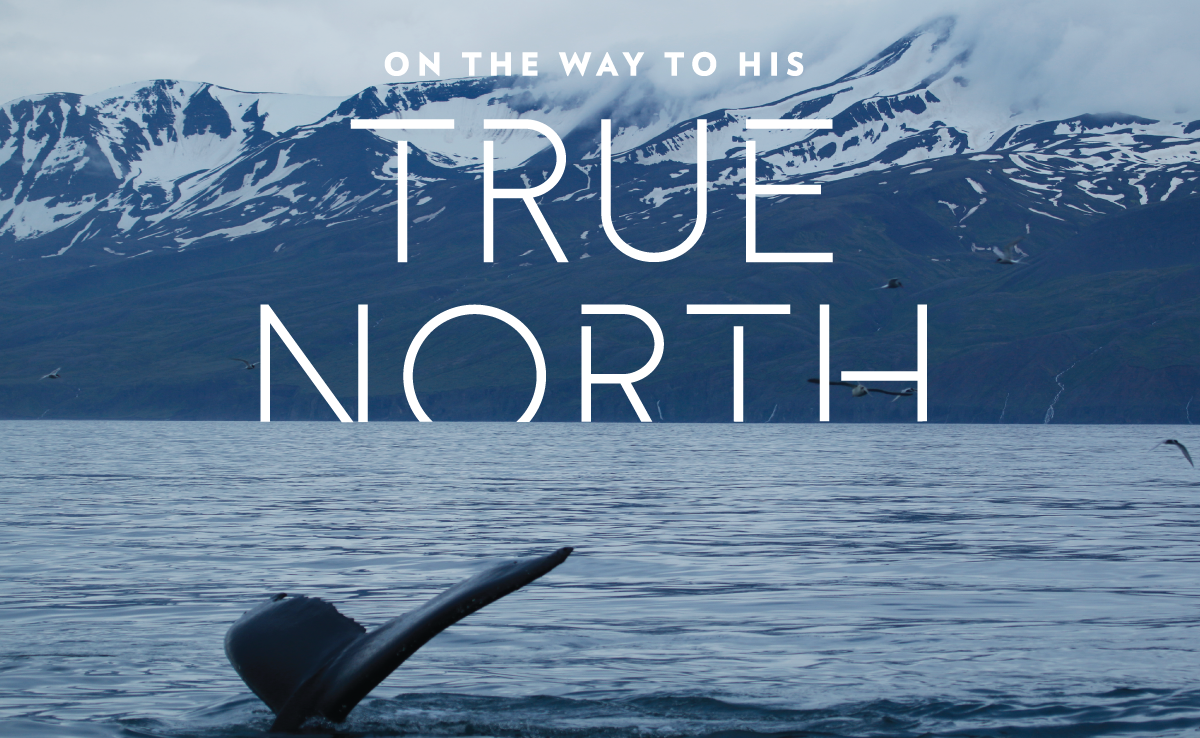On the Way to His True North
If not for a simple, hand-drawn map, Danny Kosiba ’17 would not be where he is today, nor where he was six months ago, nor where he was a year before that.
Spare though neatly illustrated, the map would not only guide him to a physical destination in the Cook Islands, but it led to a newfound passion, too. There was no way of knowing it at the time, as is often the case with all truths found in hindsight, but that map — a providential talisman — was the cartographic directive Kosiba would use to journey in the South Pacific, then to the North Atlantic, and now to a hoped-for future in whale research.
How did a biology major from a midwestern American college find himself enamored by marine biology particularly, and whale research specifically, half a world away from home? Short answer: By dint of pluck and intellect. Long answer: We’re going to have to track back a bit, back to how Kosiba was handed that map in the first place.
As a senior at Hope, Kosiba studied abroad for a semester in New Zealand. He chose the land of kiwis and jaw-dropping landscapes because, he admits, he’s a huge Lord of the Rings fan. “Studying in the natural world depicted in those movies was very appealing to me,” says Kosiba, whose hometown is Vicksburg, Michigan. “Plus, New Zealand has none of the scary poisonous stuff Australia has,” the jocund 22-year-old adds.
Off Down Under, Kosiba enrolled in his first marine biology class and took an optional spring break field trip to Rarotonga, the largest of the 15 Cook Islands. For seven days, he had the opportunity to explore and listen to various Cook Island experts, one of whom happened to be Nan Hauser — a world-renowned whale biologist, president and director of the Center for Cetacean Research and Conservation, and subject of Animal Planet, Discovery Channel, National Geographic and Smithsonian films.
Hauser’s style and lecture captivated Kosiba, so contagious was her enthusiasm for the study of whales. And so inquisitive was the Hope student that he introduced himself to the famous researcher and then asked for her audience at another time.
“So, she draws me a map to come visit her at her home,” Kosiba says. “There wasn’t much to it. A short line for the main road plus a couple other landmarks, like a pile of rocks here and a rugby field there.”
Hauser may have thought Kosiba would never take her up on the invite, but she clearly didn’t know his intrepidity very well. For much longer than it was supposed to take the next day, Kosiba and a friend trekked Rarotonga’s exterior, then its interior… through a tropical rainstorm… over muddy, lesser delineated roads… in search of Hauser. In isolated, rugged terrain with no one around to ask for directions, the two became lost. The temporary inconvenience would give way to a somewhat Stanley-and-Livingstonian moment.
Finally, in the Middle-of-Nowhere, Rarotonga, the two explorers found Hauser’s house and knocked without reserve on her door. Invited into her kitchen, they sat, towels draped over their soaking selves, and peppered the veteran scientist with an intense Q-and-A of why’s and how’s and what’s of whale research. In the end, the conversation turned out to be a job interview Kosiba didn’t know he was having.

Whale research, no matter where it happens, is a demanding, under-funded field. Making a meaningful contribution requires 100 percent commitment and unwavering devotion to the cause.
“Nan was interrogating us, too,” Kosiba recalls. “She was like, ‘Why did you come out here? Why do you care?’ By the end of our talk, she asked, ‘Why don’t you just come back and help me with the whales this summer?’ My first reaction was, ‘You’re joking, right? I don’t know anything about the ocean and I certainly don’t know anything about whales.’ But she was super enthusiastic, so I had to do it. And that’s how I got my mind completely into marine biology.”
None of this surprises Dr. K. Greg Murray, the T. Elliot Weier Professor of Plant Science at Hope. As one of Kosiba’s biology department mentors, Murray worked with him enough to know that Kosiba’s propensity to adventure is both inherently rooted and educationally grounded.
“I think a famous Louis Pasteur quote, admittedly paraphrased, applies very well to Danny and his experience: ‘Serendipity favors the prepared mind,’” Murray comments. “The prepared mind recognizes an interesting question when it sees one, knows enough, or sometimes just enough, to pursue it, and then has the courage to do so even outside the comfort of familiar surroundings. That’s what a broad education should do for us, but of course we have to bring certain personality traits to the table first. Danny clearly did that, has that.”
Though Kosiba had his Cook Islands experience while he was a Hope student, his Icelandic opportunity happened after his graduation with honors in December 2017. Thanks to Hauser’s recommendation and Kosiba’s reputation, Ph.D.-candidate Tom Grove of Wales asked the recent Hope grad to join his team studying humpback whales’ stress levels, theorized to become elevated during the burgeoning whale-watching season off the coast of Husavik, Iceland. At the peak of summer tourist-time, which also coincides with the whales’ feeding season in the North Atlantic, approximately 60 tour boats cruise out each day to whale-watch. At times, there can be six or seven tour boats surrounding a single animal.
“We have to balance a good educational experience for guests onboard a boat who want to have this bigger connection with these charismatic animals,” Kosiba starts, “with the boats’ large size, close proximity and loud noise. We wanted to determine if all of that has an effect on the whales.”
Since taking a blood sample from a wild, 100,000-pound giant to test for increased stress hormones was definitely out of the question, the Iceland research team invented a new approach using old-fashioned supplies coupled with new-millennium technology. Navigating a drone with petri dishes attached to it by using a common coat hanger, duct tape and a zip-tie, the research team would fly the device through the multiple-meter-high spout that whales create when they exhale at the surface.
“The process was as hairy and troublesome to perfect as it sounds, but in the end, it does work,” Kosiba explains. “We are officially one of the first groups to ever successfully sample in such a way and were at the forefront of a fantastic new ecological technique with tons of future possibilities… Now with all of this data collection, we are aiming to inform more sustainable whale-watching practices in Iceland, and hopefully other places by extension.”
Like the icy North Atlantic air he inhaled, the experience was exhilarating. Yet, whale research, no matter where it happens, is a demanding, under-funded field. Making a meaningful contribution requires 100 percent commitment and unwavering devotion to the cause. “You have to truly believe in the work you are doing and give it your all,” Grove explains. “Fortunately for us, this was never in doubt with Danny. His attitude towards our research was one of hard work and enthusiasm. The way in which he was able to combine this work ethic with his friendly and sociable personality was seriously impressive. In fact, it was crucial to encouraging others to contribute.”
Kosiba really can’t help himself because, through it all, he’s just been himself. How else can you explain the adaptability and scientific dedication of a guy who took two unpaid whale-research internships, especially in countries with high living costs? Using his savings, supplemented with an occasional odd job or dumpster-diving excursion outside grocery stores, the young biologist is simply unperturbed by what it takes to follow his calling. “You gotta do what you gotta do,” he says. “You’ll hear no complaints from me.”
Today, Kosiba is in Oxnard, California, back on another coast. This time he is working in an AmeriCorps-affiliated program called Civic Spark. There, he is looking at climate-related science to recommend coastal-plan updates and then communicating those plans to the community. He sees this newest escapade as a way to round himself out, to be involved a little more in policy and outreach instead of strictly working with data. Through every empirical step, Kosiba has been grateful for an alma mater that prepared him well for it all. “Hope provided me with just tons and tons of opportunities and I undoubtedly feel that put me a bit ahead of some other people in the field,” Kosiba says. “I’d find myself thinking a lot, ‘Thank you, Hope.’”
His memories of those oceanic behemoths still loom large. So does the spiritual connection he felt with those “angels of the sea,” their force of nature making him “feel nearer to God,” he says. More of that is what Kobisa wants, so he plans to apply to graduate programs in marine biology as he fills his gap year on the West Coast. Conservationism, whether for cetaceans or more earth-bound, will remain at the forefront of his thinking for the future. And it’s not a stretch to think that Danny Kosiba will have no problem eventually charting a way to his own true north.



One thought on “On the Way to His True North”
Comments are closed.